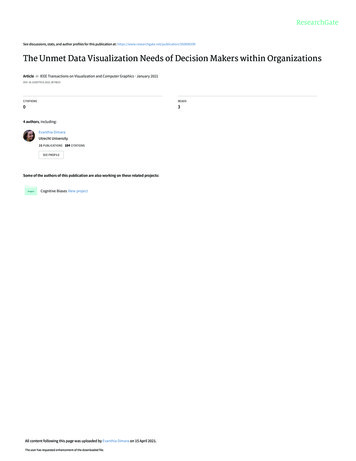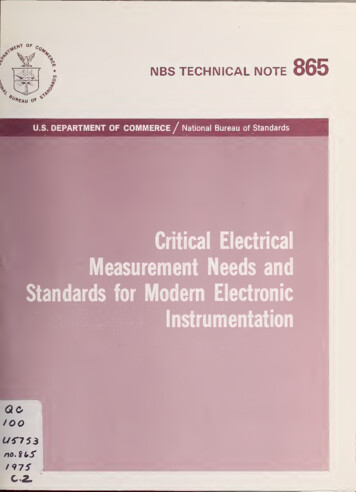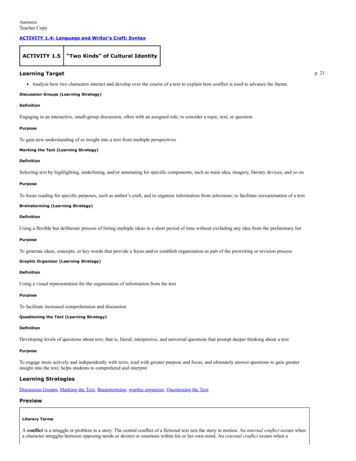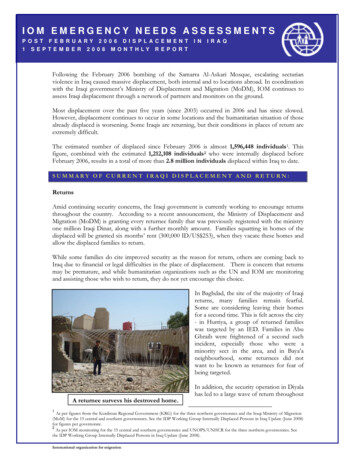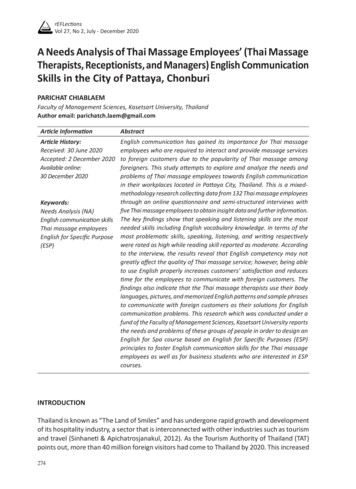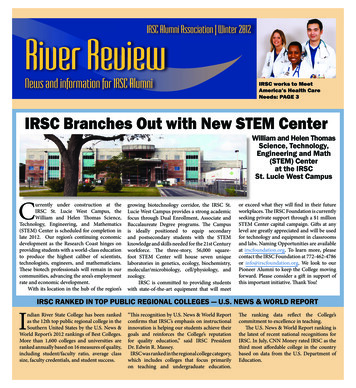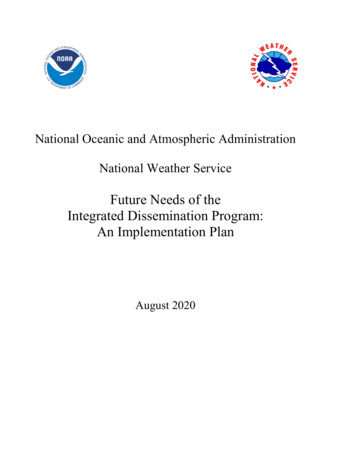
Transcription
National Oceanic and Atmospheric AdministrationNational Weather ServiceFuture Needs of theIntegrated Dissemination Program:An Implementation PlanAugust 2020
Future Needs of the Integrated Dissemination Program, an Implementation PlanExecutive SummaryBeginning in FY 2014, the National Weather Service (NWS) replaced a collection ofindependent, sub-optimal and undocumented regional dissemination systems with an integratedoperational common dissemination service to better support the NWS mission to protect livesand property. This effort was initiated with the congressionally appropriated IntegratedDissemination Program (IDP). For decades, the NWS relied on a non-redundant infrastructure todeliver life-saving watches and warnings. Without a centrally managed nationally supportedinfrastructure, NWS regional offices and National Centers developed their own networks,applications, product delivery services, and web sites to meet customer and partner needs.When establishing IDP as an on premise private cloud, it became evident that it would take fiveplus years to build the infrastructure, onboard the original funded suite of mission-criticalapplications, and develop the expertise to support it. Phase One was resourced for around 40percent of the total mission-critical dissemination-based applications and with those resourcesNWS successfully consolidated and upgraded the network bandwidth, and transitioned twentycore services to IDP. Phase One ended in FY 2018, with IDP providing primary and backupservices, 24 hours a day, seven days a week for a subset of mission-critical disseminationapplications.With the initial success transitioning core delivery services of watches and warnings to IDP,NWS entered into Phase Two to initiate the onboarding of the remaining mission criticalservices. However, attempts to transition some of the remaining mission-critical functions, suchas weather.gov and SPOT, from the old legacy systems to IDP proved problematic and transitionefforts for these functions halted. Despite a few setbacks, NWS continued the effort to improvethe delivery reliability and public display of model, observational, and high-resolution radar data.Phase Two is ongoing and involves specialized support, received by the one-time approvedreprogramming from the IDP infrastructure vendors, as they optimize the performance andreliability of the system. Phase Two also encompasses the transition of three remaining andadditional mission-critical applications to the system in FY 2021, including the All-HazardsEmergency Message Collection System (HazCollect), NWSChat, and the Advanced HydrologicPrediction Services (AHPS) (Figure 1). While onboarding these three applications to IDP willimprove the risk posture for NWS dissemination mission failure, 19 critical disseminationapplications and services continue to operate on end-of-life hardware on legacy web farms andcan fail at any time. To circumvent this eventual mission failure, Phase 3 could be resourced tocomplete the onboarding of mission-critical applications to IDP while in parallel executing theExecutive Order to implement a Cloud Smart strategy transitioning appropriate NWS services toa NOAA public cloud environment.2
Future Needs of the Integrated Dissemination Program, an Implementation PlanFigure 1: Depicts the success of IDP Phase 1 and 2 through July 2020. The right side lists the applicationscurrently running operationally on IDP and the left side shows the remaining applications funded fortransition.Today, the underlying IDP infrastructure has improved bandwidth and resilience, and it providesredundant, scalable, and secure operational networks and systems; including the onboarding ofthe NWS Gateway with full backup capabilities for the first time in the history of the NWS. TheIDP infrastructure and its applications are monitored and tracked on a 24x7 basis. However, asmentioned, 19 additional mission-critical applications and web services, such as weather.gov,NOAA Weather Wire Service, and SPOT (application that supports fire weather point forecasts)remain on legacy end-of-life servers (complete list in Appendix B). Applications, such as these,do not perform at the same level of robustness of the IDP applications due to both the age of thesoftware and the end-of-life hardware they run on. To ensure NWS Leadership is aware of anyissues with the overall operating stature, a daily “stand up” meeting occurs each morning toreview and discuss any disruptions in services on all NWS systems, including both IDP and nonIDP applications (Figure 2).Figure 2: A snapshot of NWS monitored system status dashboard reported daily.3
Future Needs of the Integrated Dissemination Program, an Implementation PlanIDP maintained an average availability time greater than 99 percent in FY 2019 and, to date, IDPis hovering around 99 percent in FY 2020 (Figure 3). It is important to note these metrics onlyreflect the availability of applications running operationally on the IDP in College Park, MD andBoulder, CO and do not encompass the non-IDP applications still residing on the less reliablelegacy systems.Figure 3: IDP Virtualized Private Cloud Infrastructure Current Uptime AvailabilityThe intent of this plan is to not only complete the transition of the remaining mission-criticalapplications and delivery services to IDP, but also, demonstrate the viability of a public cloudplatform to host and deliver non-Primary Mission Essential Functions (PMEF) through a “CloudSmart” approach. NWS has mapped out two additional phases to accomplish this intent. Phase Three – a focused effort to further strengthen IDP performance and continuereengineering and migrating the remaining mission critical applications anddissemination services to IDP. Phase Four - currently in progress with limited scope and would continue in parallel withPhase Three. The initial step is the implementation of an economic framework to assistNWS in evaluating the benefits, risks, and strategic impact of moving to the public cloud.Pending the results of evaluations and current FY 2020 demonstrations, Phase 4 wouldinclude transitioning appropriate development environments and applications, some ofwhich currently reside wholly on IDP, to hybrid or public cloud environments.Phase Three has not yet been resourced. However, NWS has developed strategies to transition19 applications onto the redundant and secure IDP platform. These 19 NWS mission-essentialapplications currently reside on legacy platforms with no backup and only some with 24x7support. At the completion of Phase Three, IDP and the PMEFs it supports could more securelyprovide the high availability, stability and reliability of essential data required to provide4
Future Needs of the Integrated Dissemination Program, an Implementation PlanIntegrated Decision Support Services on the web, directly to our core partners (EmergencyManagement community), the entire weather enterprise, and the American Public.Phase Four has begun and will continue in parallel with Phase Three (see Figure 4). With acareful and deliberate approach and with the limited resources currently dedicated, NWS is ableto continue evaluating applications for the cloud, and transition some services includingdevelopment environments to a public cloud solution. If fully funded in a future budget, PhaseFour would continue to run in parallel with Phase Three creating a hybrid cloud solution withPMEF applications running operationally in the private on premise cloud, transitioningapplication development environments to the public cloud, and re-architecting existingapplications and web services to host on the public cloud based on the evaluation efforts.Initiated in late FY 2018, the NWS contracted an external consulting firm to provide the NWSwith an objective cloud-decision framework that aligns itself with the NOAA Cloud Strategy.The decision framework provides a financial model to evaluate the costs, benefits, and risksassociated with operating within the public cloud. Also included in Phase Four is an effort toassess applications currently on IDP, as well as those identified for migration to IDP, todetermine if utilizing the public cloud as a host would meet the requirement of the applicationwith reengineering efforts, create efficiencies, and be cost effective. To date, NWS hassuccessfully demonstrated transition of the Damage Assessment Toolkit application to theNOAA Amazon Web Services Cloud and worked closely with NOAA OAR to migrate thedevelopment environment of the Multi-Radar Multi-Sector (MRMS) application to a publiccloud environment. The Gantt chart for all four phases is presented in Figure 4.Figure 4: High Level Gantt chart of IDP Phase 1 - Phase 45
Future Needs of the Integrated Dissemination Program, an Implementation PlanBackgroundThe NWS mission depends on the delivery of critical data to forecasters within NWS, as well asthe public, and the Weather Enterprise to meet its mission to protect lives and property andenhance the national economy. The NWS mission is at risk of degradation if information is notdelivered in a reliable and timely manner.In FY 2014, in response to a series of significant infrastructure outages that affected the ability ofthe NWS to execute its mission, including the issuing of warnings during severe weather events,the NWS established the Integrated Dissemination Program. The goal was to transform theorganization’s dissemination capabilities from a collection of independent disseminationstovepipes to an integrated operational common dissemination service in an on premise privatecloud.Although the vision of IDP was to address all mission essential applications, NWS defined thescope of IDP Phase One, focusing on a subset of the most critical systems needed to deliverNWS watches and warnings. The goals for IDP included: Demonstrate the operational viability of using an on premise private cloud for NWSenterprise dissemination services Provide fully redundant primary and backup dissemination services with a geographicallydiverse infrastructure for a targeted subset of NWS critical systems Improve bandwidth, resilience, scalability, and secure operational networks and systems Increase access to environmental data using diverse methods and data formatsNWS has met and exceeded this original scope. During the completion of Phase One, manymission-essential applications were discovered running on unsupported equipment with nobackup. In order to continue to provide reliable weather-based services, the off-premise publiccloud solution offers the potential to host more applications with high reliability.IntroductionPhase One - CompleteThe IDP was a multi-year response to ensure reliable and secure information dissemination tosupport the NWS mission and to help build a Weather-Ready Nation (WRN). NWS confined thescope of Phase One to: Transitioning a subset of applications and services related to NWS watches and warningsto IDP Consolidating and upgrading the network bandwidth Standing up GOES Re-Broadcast Antennas at eight locations to support Himawari-8,GOES-East, and GOES-West6
Future Needs of the Integrated Dissemination Program, an Implementation PlanNWS achieved the original scope of the program, and Full Operating Capability (FOC), in FY2018, transitioning an initial 20 applications to the platform, and subsequently transitioning 16additional mission-critical applications. The technology infrastructure created through the IDP isan on premise private cloud infrastructure and deployed at two geographically diverse locations.This effort resulted in a 100 percent backup capability for the delivery of NWS reliable andtimely critical observations, model guidance, forecast, and watches and warning information forthe first time in history. The OneNWS Network is operationally used at all NWS ForecastOffices, River Forecast Centers, Regional Headquarters, and National Centers to supportmission-critical coordination. Data delivery services were upgraded and the bandwidth wasincreased by tenfold. The original scope of IDP also included the move of the “singular” gatewayin Silver Spring to a fully backed up system in College Park, MD and Boulder, CO, representingthe first time ever that the NWS Gateway could operate as a fully backed up system. The design,procurement, and installation of eight NWS Geostationary Weather Satellite Antenna Systems(GWSAS) were also accomplished at CONUS NWS locations, and two Himawari-8 SatelliteAntenna Systems (Himawari-CAST) at OCONUS NWS locations. These enabled the receipt,processing, and display of data from the GOES-East, GOES-West, and Himawari-8 satellites.This new satellite imagery allows the NWS to forecast with more precision due to the enhancedresolution and timely receipt of the data at the critical National Centers.Since reaching FOC, at the end of Phase One, the IDP has proven to be a powerful resource forthe NWS. This was evident during the historic 2017 hurricane season when the IDPinfrastructure, upgraded OneNWS Network, and a newly implemented video-enabled hurricanehotline communication system performed flawlessly during the most critical time as multiplestorms affected the U.S. and Caribbean countries. However, the level of demand the NWSanticipated on the system, based on outside evaluation, far exceeded expectations. The IDPinfrastructure is reaching its maximum capacity and demand continues to grow, forcing NWS tore-evaluate which applications are most critical to host on the system.Implementation PlanPhase Two - Enhancements Currently OngoingOutages began to occur in FY 2018, bringing the availability of IDP below 99 percent (seeFigure 3). These outages were attributed to a misconfiguration of the internal networking of theIDP infrastructure. At the time the infrastructure was built, using virtual machines withscalability to increase access to data in multiple formats, the IDP truly pushed the limits oftechnology. The decision to use virtual machines rather than purchasing the equivalent hardwareat significantly greater cost allowed NWS to meet the requirements of the overall program at alower cost. However, a misconfiguration became evident once the system became operational.To correct this, NWS required an infusion of expertise to strengthen the overall system stability.Beginning in FY 4Q 2019, NWS used 5 million of reprogrammed funds to contract with highlyspecialized subject matter experts from the IDP infrastructure vendors, and 11 highly skilledsystem administrators, for a period of 18 to 24 months. These contractors will document,7
Future Needs of the Integrated Dissemination Program, an Implementation Planconfigure, and optimize the performance and reliability of the IDP systems and transferknowledge to NWS IT personnel. This additional expertise reduces the risk of future outages,and will reduce the duration and impact of any outages that do occur. NWS is transitioningadditional applications to IDP to improve reliability of those applications, and maintainingexisting applications to meet both customer and security requirements.While transitioning all remaining mission-critical applications and services will not be possiblein Phase Two, the NWS through the Mission Delivery Council (MDC) prioritized a subset ofthese applications (Table 1) that require primary and backup services. Failure of this subset ofapplications generates the most immediate operational risk. In response, NWS is now preparingto on-board these applications through annually appropriated funds, funds reprogrammed to theOffice of Dissemination during FY 2018, and hurricane supplemental funding from FY 2017.The critical applications transitioned with base and hurricane supplemental funding include theSatellite Product Analysis and Distribution Enterprise System (SPADES), the Radar IntegratedDisplay and Geospatial Elements 2 (RIDGE2), and the Enterprise GIS National Viewer for floodinundation mapping. Mitigation measures are being explored to improve robustness in the face ofdemand for the most essential legacy web-based applications such as NWSChat while awaitingtransition to IDP. NWSChat, for example, is a primary communication and coordination toolused by meteorologists, core partners and the media to quickly exchange rapidly changingforecasts, observations and warning information.The remaining 3 million of 8 million of reprogrammed funds enabled the NWS to acceleratethe on-boarding or enhancement of three critical applications to IDP ensuring 100 percentbackup capability in the event of a primary system failure. These next-to-be on-boardedapplications are the Advanced Hydrologic Prediction Service (AHPS), NWSChat, and the newlydesigned All-Hazards Emergency Message Collection System (HazCollect), also called CAPHandler, which works with FEMA IPAWS to disseminate life-saving alerts and warnings.Initiating in early FY2019, hiring and training contractors as well as preparing and on-boardingthese three applications will take approximately two years, in total, and is expected to becompleted by the end of FY2021. Once the Phase 2 applications that provide NWS PMEFs aretransitioned to IDP, the storage, compute, and bandwidth to the Internet will reach full capacityby the end of FY2021 leaving 19 critical applications and services without a sustainable home.Table 1: Phase Two – MDC Prioritized Application Enhancements and On-boardingMDCPurpose of Application orApplication NameapprovedEnhancementsequence1Satellite Product Analysis andDistribution Enterprise System(SPADES)Initial Phase 1 implementation ofGOES-16/17 space weather relatedsatellite productsEstimatedCompletionCompletedQ1 FY 20208
Future Needs of the Integrated Dissemination Program, an Implementation Plan2aviationweather.gov3Radar Integrated Display withGeospatial Elements 2(RIDGE 2)4Implement updatedHAZCOLLECT application, NWSCommon Alerting Protocol (CAP)Handler application, to ingest anddeliver Non-Weather EmergencyMessages from FEMA IPAWSNWSChat56Advanced Hydrologic PredictionServices (AHPS)7NWS Enterprise National GISbased Viewer (Hybrid Cloudapproach)Implement secondary instance ofNWS Aviation Weather Center(AWC) site on IDPCompletedImproved spatial resolution, andenhanced images of radar data.Current services reside on legacy webfarmThe application to ingest non-weatheremergency messages from FEMAIPAWS and rebroadcast over NOAAWeather Radio (NWR) is sporadic andunreliable. This will replace twolegacy applications.Allows for mission-criticalcollaboration between decisionmakers.Provides water-focused web-servicesincluding water heights at river gaugelocations current and forecasted.These services currently reside onlegacy web farm.Supports flood forecasting andinundation mapping such as WPC andOWP GIS Products.Q1 FY 2021Q3 FY 2020Q2 FY 2021Q4 FY 2021Q3/Q4 FY2021Q4 FY 2021or Q1 FY2022Phase Three – Continued IDP Onboarding of Mission-Critical Applications (If Resourced)Today, IDP supports 36 applications operationally (see Appendix A). By the end of Phase Twoin late FY 2021 / early FY2022, seven additional applications will run operationally on IDP andat that point IDP will be at full capacity. NOAA developed plans for FY 2022 and beyond totransition up to 19 remaining mission-critical applications and web services to IDP (AppendixB). These applications, while critical to the mission, do not currently perform at the level NWSstakeholders require. The decision to further invest in these applications will depend on anassessment of stability of aging hardware, level of redundancy and/or developmentenvironments. The primary mechanisms to properly disseminate critical life and safety warningsto the public are NOAA Weather Radio (NWR), broadcast services, and phone-based emergencyservices. However, it is clear NWS Partners in the Emergency Management community rely oninformation provided by these applications and web services to support and execute their missionand warn
a NOAA public cloud environment. Future Needs of the Integrated Dissemination Program, an Implementation Plan . 3 . Figure 1: Depicts the success of IDP Phase 1 and 2 through July 2020. The right side lists the applications . stovepipes to an integrated operational common dissemination



